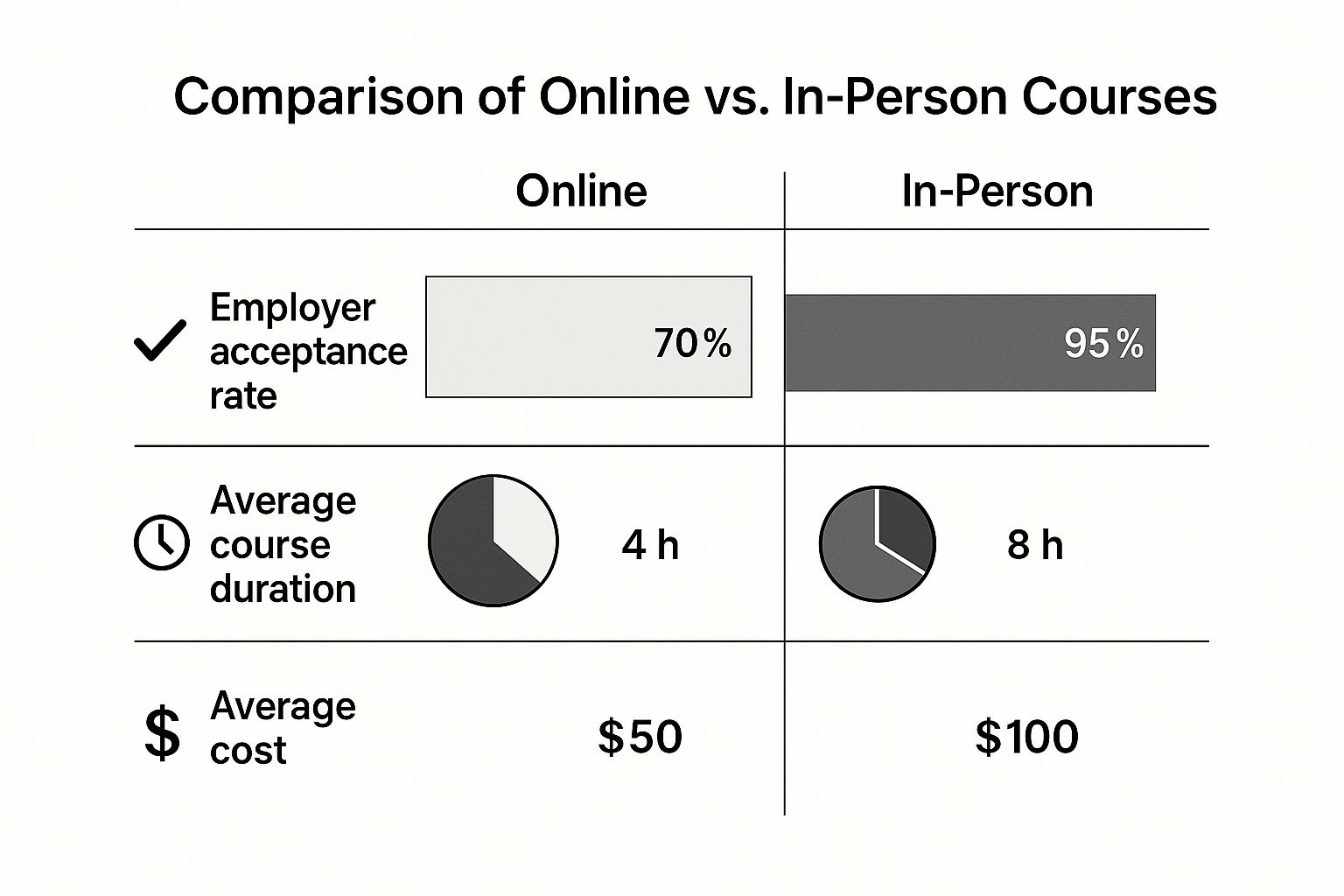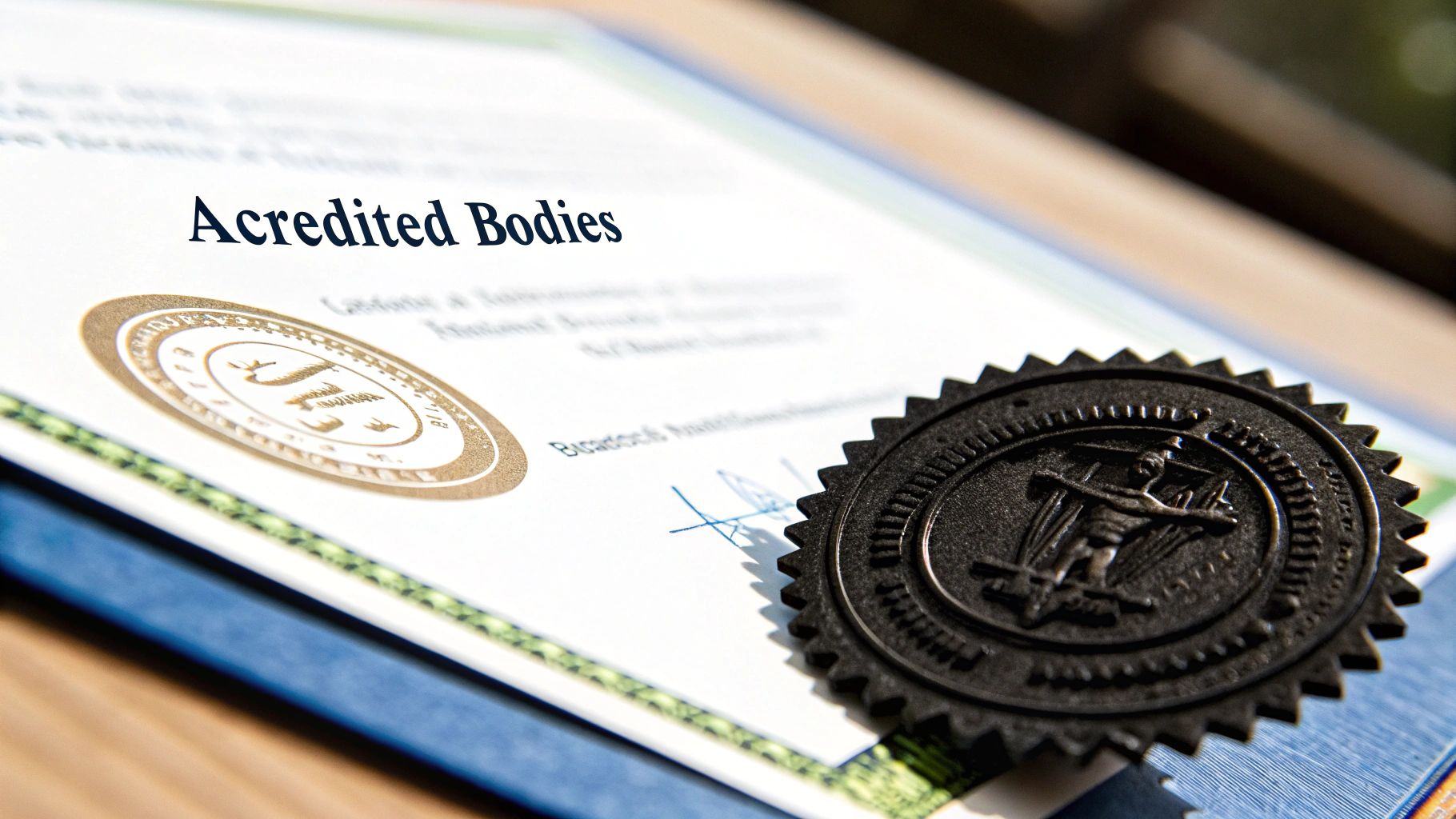Let's get straight to the point: is online CPR certification valid?
For most professional or workplace requirements, the answer is a firm no—at least, not if the course is 100% online. Major regulatory bodies like OSHA and standard-setting organizations such as the American Heart Association (AHA) are crystal clear on this. They require a hands-on skills test to make sure you can actually perform these life-saving techniques when it counts.
The Truth About Online CPR Validity
So, where does all the confusion come from? It usually boils down to a simple misunderstanding of what makes a CPR certificate "official." Countless websites offer quick, fully online courses, and while they might cover the book smarts, they skip the one part that employers and agencies consider non-negotiable: a practical skills assessment with a certified instructor.
This is exactly where blended learning steps in. It’s the modern, widely accepted solution that gives you the best of both worlds.
- Online Convenience: You cover all the learning material—watching videos, reading, and taking the written test—from your own computer, on your own time.
- Hands-On Proof: You then attend a short, in-person session to practice on a manikin and prove to an instructor you’ve got the skills down.
This approach combines flexibility with the credibility of a traditional class.

The data here really tells the story. While a 100% online course might seem faster and cheaper upfront, that low employer acceptance rate highlights the risk you take by choosing a non-compliant option.
Why Hands-On Practice Is Non-Negotiable
This isn't just about checking a box for a workplace rule. The need for effective CPR is a matter of life and death. In the United States alone, around 436,000 people die from cardiac arrest each year. What’s truly alarming is that only about 40.2% of victims outside of a hospital receive bystander CPR.
That statistic represents a massive gap between someone collapsing and someone with the confidence to step in and help. True training builds that confidence and muscle memory—something you just can't get from a screen.
The real question isn't just about getting a piece of paper. It's about being genuinely prepared to act when seconds matter. A blended course ensures you have both the knowledge and the proven skill to save a life.
For anyone who needs a certification for their job, understanding if online-only CPR classes are legitimate is the critical first step. A blended learning program from a recognized, authorized provider is your best bet to guarantee your certificate will be accepted and, more importantly, that you'll be ready to help.
Fully Online CPR vs Blended Learning at a Glance
To make it even clearer, let's break down the key differences between a 100% online CPR course and a proper blended learning program. This table shows you exactly what you're getting with each option.
Ultimately, while a fully online course might teach you what to do, a blended learning course ensures you know how to do it under pressure. For any formal requirement, that difference is everything.
Understanding the Different CPR Training Formats
When you decide to get CPR certified, you’ll quickly find the path isn't a one-size-fits-all journey. Think of it like getting a driver's license. You wouldn't be handed one just for passing a written test online, right? You need to get behind the wheel and prove you can actually, safely drive a car. CPR works on the exact same principle: knowing what to do is critical, but being able to do it correctly is what saves lives.
The world of CPR training has evolved, offering a few different ways to get certified. Understanding these formats is the first step in figuring out which certification is valid and right for your specific needs. Each one comes with its own set of pros and cons, catering to different schedules, learning styles, and—most importantly—different professional requirements.

Let’s break down the three main training models you'll encounter out there.
Traditional In-Person Classes
This is the classic, old-school approach. You show up at a physical location for a scheduled class that lasts several hours. Everything—the lecture, the videos, the hands-on skills practice, and the final test—happens in one session under the direct supervision of an instructor.
- Pros: You get immediate feedback on your technique and can ask questions in real-time. It’s a completely structured environment where you can knock everything out at once.
- Cons: These classes are often rigid in their scheduling, forcing you to block off a significant chunk of your day. Frankly, they can be the most time-consuming option.
100% Online Theory Courses
On the opposite end of the spectrum, you have courses conducted entirely online. You’ll watch some videos, read materials, and pass a digital quiz. Once you’re done, you can often print a certificate immediately.
These courses are the source of most of the confusion and misinformation out there. While convenient for gaining some basic knowledge, they lack the hands-on skills component required by nearly all employers and regulatory bodies like OSHA. For almost any professional purpose, these certificates are simply not valid.
Blended Learning: The Modern Standard
This hybrid model truly combines the best of both worlds. You complete the academic portion—all the videos and the written exam—online, entirely at your own pace. Afterward, you attend a much shorter, pre-scheduled in-person session to practice and test your physical skills with a certified instructor.
This is the format that has become the gold standard for legitimate, compliant certification. It respects your time by offering flexibility for the book-learning portion while still guaranteeing you have the proven, hands-on ability to perform CPR correctly when it matters most.
To get a deeper look at how these models compare, check out our guide on blended learning vs instructor-led CPR courses. For most people needing certification for their job, blended learning is the clear and accepted choice.
Who Decides if a CPR Certificate Is Legitimate?
So, what makes one CPR card an official, employer-accepted document and another one just a worthless piece of paper? It all comes down to who sets the standards for lifesaving care. In the United States, that authority belongs to a few powerhouse organizations that have spent decades researching and refining the best ways to respond to cardiac emergencies.
When we talk about legitimacy, we're really talking about recognition and acceptance. The final judge is almost always an employer, a state licensing board, or a federal agency like the Occupational Safety and Health Administration (OSHA). And who do they trust? They follow the science-based guidelines established by a handful of key players.

The Gold Standard Setters
At the top of the pyramid, you'll find two organizations whose names are pretty much synonymous with CPR training in the U.S.
- The American Heart Association (AHA): A research and education giant, the AHA is a primary source for the scientific guidelines that form the basis of modern CPR and ECC (Emergency Cardiovascular Care).
- The American Red Cross (ARC): Famous for its humanitarian work, the ARC is another leading provider of health and safety training, including CPR. Their standards are scientifically equivalent to the AHA's.
It's important to know that OSHA doesn't create its own CPR curriculum. Instead, it mandates that workplace training must come from a reputable provider and cover the topics outlined by organizations like the AHA. This is a critical point that many online-only providers conveniently gloss over. To get into the nitty-gritty, you can check out our guide on OSHA CPR certification requirements.
Decoding Misleading Marketing Language
This is where you have to be a savvy consumer. Lots of online course providers use tricky language to make their programs seem official when they really aren't. Understanding the difference between these terms is your best defense against getting a certification that your employer won't accept.
- AHA-Approved: This means the course is officially provided by the American Heart Association or one of its authorized training centers, like Ready Response. When you complete a blended learning course, you get an official AHA eCard. That's the real deal.
- AHA-Compliant or "Follows AHA Guidelines": This is just a marketing claim. It means an independent company created a course based on the AHA's public research. This is not an AHA course, and you will not receive an official AHA certification card.
A certificate from an "AHA-compliant" provider is rarely, if ever, accepted for professional requirements. Employers who require AHA certification will only accept the official eCard issued by an authorized training center that conducted a hands-on skills session.
The validity of your certificate isn't just about the name on it; it's also about how long it lasts. Most recognized courses, including those aligned with AHA guidelines, issue a digital certification that is valid for 24 months. This ensures you're up-to-date with the latest techniques for both professional and personal use.
Ultimately, legitimacy isn't determined by a slick website or a low price. It's decided by the organizations that set the national standards and, most importantly, the employers who have to follow them.
Why Your Job Requires Hands-On CPR Training
For most people looking into CPR certification, the real question isn't just about theory—it's about practicality. The most common, and most important, question we get is this: will my employer actually accept this certificate? This is where the online-only CPR debate gets very real, very fast. Showing up to a new job with the wrong type of certification isn't a small mistake; it could put your job on the line before you even start.
The Occupational Safety and Health Administration (OSHA) sets the standard for workplace safety, and they don't mince words. For a CPR certification to be valid for most jobs, it must include a hands-on, practical skills demonstration. An instructor needs to physically watch you perform chest compressions and rescue breaths on a manikin to confirm you’re doing it right. A 100% online course simply can't meet this core requirement.
Careers Where Hands-On Is Non-Negotiable
This isn't just a bureaucratic rule. For a huge number of professions, being able to physically perform CPR is a fundamental part of the job. Can you imagine a nurse, a firefighter, or a paramedic trying to save someone's life based only on a video they watched? The confidence and muscle memory just wouldn't be there when it counts.
Here are just a few of the jobs where a 100% online certificate is almost certain to be rejected:
- Healthcare Professionals: Nurses, doctors, paramedics, dental assistants, and physical therapists all need accredited, hands-on training from recognized providers like the American Heart Association.
- First Responders: The skills of police officers, firefighters, and security guards must be proven in practice, not just learned on a screen.
- Educators and Childcare Providers: Teachers, daycare staff, and camp counselors have a profound responsibility for the children in their care. Their training has to be thorough and hands-on.
- Fitness and Recreation Staff: Personal trainers, coaches, and lifeguards are frequently the first to respond in an emergency. It's also worth noting that many specialty certifications, like the PADI Rescue Diver Course, specifically mandate in-person CPR training as a prerequisite.
The Real-World Consequences of a Non-Compliant Certificate
Let's walk through a common scenario. A newly hired personal trainer proudly hands over their "instant" online CPR certificate. The gym's manager, who has to follow strict insurance and liability rules, has no choice but to reject it. Why? It lacks the required hands-on skills check. Now that trainer can't work with clients, is out of compliance, and is scrambling to find a legitimate blended learning course at the last second.
Showing up with a 100% online certificate for a job that requires hands-on skills is like showing up to a construction site with a toy hammer. It might look the part from a distance, but it’s completely useless for the actual job.
This exact situation happens all the time. It can lead to job offers being pulled, failed workplace safety audits, and even serious legal trouble for the employer. Understanding the need for CPR training in the workplace is about more than just checking a box—it's about keeping everyone safe. Choosing a blended learning course from the get-go is the smartest, most reliable way to protect your career and ensure your certification is accepted everywhere.
When Does a Fully Online CPR Course Actually Make Sense?
So, after establishing that almost any job-related certification is going to require a hands-on skills session, you might be thinking: is a 100% online CPR course ever a good idea? The answer is a definite yes—but only in the right situations. While they don't meet the mark for most professional requirements, these courses are fantastic for making lifesaving knowledge accessible to the general public.

Think of it like learning to cook from a recipe book versus going to culinary school. That book gives you amazing recipes and techniques you can use at home, but you wouldn't get hired as a head chef based on that knowledge alone. In the same way, a fully online CPR course is an excellent tool for personal preparedness.
For Personal Preparedness and Peace of Mind
For a lot of people, the goal isn't to get a certificate to hand in to HR; it’s about having the peace of mind that comes from knowing what to do in an emergency. This is exactly where 100% online courses shine.
- New Parents and Grandparents: Learning the fundamentals of infant and child CPR is an incredibly valuable skill for anyone with little ones running around. An online course is a convenient, low-stress way to get that foundational knowledge.
- Babysitters and Nannies: While some families might insist on an official certification, many just want to know their caregiver has a solid grasp of emergency procedures.
- Community Volunteers: People who volunteer for organizations that don't have strict certification rules can gain a lot of valuable awareness from an online-only course.
A Great Introduction to Lifesaving Skills
Another huge plus for online-only courses is that they serve as a perfect entry point into formal training. Let's be honest, not everyone is ready to jump into a full blended learning course right off the bat. An online module can feel more like a "test drive," letting you get comfortable with the ideas and terminology before you ever step into a classroom for the hands-on part.
A fully online course can build foundational awareness and confidence, making the transition to a hands-on skills session feel much less intimidating. It’s an effective first step on the path to becoming fully certified.
This approach really helps demystify the whole process, making lifesaving education feel more approachable for everyone.
So, is online CPR certification valid for your own personal knowledge? Absolutely. It's a powerful way to spread awareness and empower more people to act in an emergency. For those who later realize they need or want an official card, making the switch to a blended program is simple.
When you're ready for that next step, it's critical to understand the factors involved in choosing the right CPR training provider to make sure you get a certification that truly meets your needs.
How to Find a CPR Program That Meets All Requirements
Alright, so you get it. A blended learning course is the only way to go if you want a CPR certification that’s both convenient and actually accepted by your employer. But a quick search shows just how many providers are out there. How do you cut through the clutter and find one that truly checks all the boxes?
This isn't a time for guesswork. It's about having a clear, actionable checklist to make sure you’re signing up for a legitimate program. By asking a few direct questions, you can invest your time and money wisely.
Confirm the Blended Learning Model
First things first, you need to know exactly how the course is structured. Your initial question to any provider should be simple and to the point: "Do you offer a blended learning course that includes a mandatory in-person skills session?"
If they say no, or worse, try to convince you a 100% online certificate is "just as good," that's your sign to move on. A real, recognized provider will be upfront about their two-part process:
- The Online Part: They’ll give you access to an online learning module to complete on your own time. For an American Heart Association course, this is usually their HeartCode® program.
- The Hands-On Part: They must have a clear system for you to schedule your skills test at a real-world location with a certified instructor.
Locate a Nearby Skills Session
This next step is a big one, and it's where a lot of people get tripped up. Before you pull out your credit card for the online module, make sure you can actually finish the course. It’s a classic bait-and-switch to sell you the online portion, only for you to discover their closest "training center" is three states away.
Always, always, always confirm the location and availability of in-person skills sessions before you pay for anything. A reputable provider like Ready Response will have a network of accessible locations and a simple scheduling system, making it easy to find a session near you.
Vet the Provider and Certification
Now it's time to do a little digging to make sure the provider is the real deal. You need to be positive that the card you get at the end is the official one your employer or school requires.
Here are the critical questions to ask:
- "Are you an authorized American Heart Association (AHA) or American Red Cross (ARC) training center?" This is non-negotiable. Only authorized centers can issue official, recognized certification cards.
- "Will I receive an official AHA BLS eCard (or equivalent) when I pass?" You want to steer clear of anyone offering a generic "certificate of completion." The official eCard is the verifiable proof you need.
- "Is your course material based on the latest ILCOR/AHA guidelines?" Lifesaving science is always improving, and your training needs to reflect the most current, evidence-based practices.
Following these simple steps will protect you from wasting time and money on a worthless certificate. As an authorized AHA training center, Ready Response proudly meets every one of these requirements, ensuring your blended learning experience is smooth, compliant, and leaves you with a CPR certification that truly counts.
Common Questions About Online CPR Validity
Even after laying out all the facts, some questions seem to pop up over and over. It's understandable—you want to be absolutely sure your certification will count. Let's clear up any lingering confusion with straightforward answers to the most common concerns.
Will My Employer Accept a 100% Online CPR Certificate?
In almost every case, the answer is no. Most employers in healthcare, childcare, education, and other regulated fields have to stick to OSHA and American Heart Association (AHA) guidelines. A core part of those standards is the hands-on skills test to prove you can actually perform the techniques correctly.
A certificate from a course that's 100% online is missing that critical, in-person skill check. To save yourself the headache, your best bet is always a blended learning program that includes this hands-on component.
What Is the Difference Between AHA-Approved and AHA-Compliant?
This is a big one, and the difference is crucial.
"AHA-approved" means the course is offered directly by the American Heart Association or one of its authorized training centers. When you pass, you get an official AHA eCard. This is the gold standard, period.
"AHA-compliant," on the other hand, is mostly a marketing term used by independent training companies. It just means their curriculum is based on the latest AHA science. While the information might be good, the certificate you get is not from the AHA and is very unlikely to be accepted for any professional requirement.
How Long Is a Valid CPR Certification Good For?
A legitimate CPR certification, whether you get it through a blended course or a traditional classroom setting, is valid for two years. This is the universal standard set by leading bodies like the AHA and the American Red Cross.
Be extremely wary of any program that offers "lifetime" certification. That’s simply not a recognized practice in the industry and is a huge red flag that the course isn't legitimate.
Can I Do the Whole Course Online and Just Get Tested in Person?
Yes, you absolutely can! In fact, you just described blended learning perfectly. This is how most people get certified today because it’s efficient and completely valid.
You complete all the knowledge-based learning—watching videos, reading materials, and taking the written exam—on your own time, online. Then, you just pop into a brief, in-person session with a certified instructor to practice and demonstrate your hands-on skills. It’s the best of both worlds.
For accredited, hands-on training that meets all professional requirements, trust Ready Response. Our American Heart Association blended learning courses guarantee you receive a certification that is valid, recognized, and prepares you to act with confidence. Learn more and sign up for a class at readyresponsepa.com.
